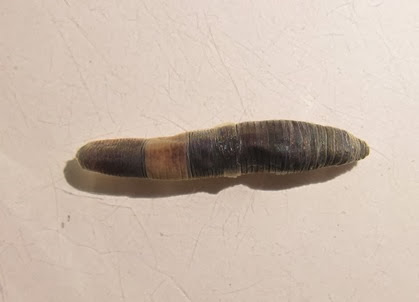Friday 28 February 2014
Return of the worm
As mentioned, since I now have a wage and days off during the week I have been able to return to volunteer with the Soil Biodiversity Group helping to sort and identify the earthworms sampled on the NERC BESS project. With my Christmas money I bought my own copy of Sims and Gerald and am learning more advanced skills in earthworm identification, with David pointing out features and giving tips on identification when the key cannot be used, like the headless Octolasion cyaneum in the first sample I looked at.
I like to start by picking out all the immature worms, for the most part these cannot be identified to species but they can be assigned to an ecotype which can still be analysed, for example any pale coloured immature earthworms are the soil feeding endogenic type. Next I move on to the damaged worms, which can be a bit of a ‘worm jigsaw’, sometimes it is possible to identify them to species if enough features are still present. Then it is on to species level identification, so far I have identified eight species from two of the fields at the Aberdeen site. The most frequent species was Aporrectodea caliginosa; I have identified 162 in ‘my’ two fields so it is exciting when something else turns up!
I have also ‘met’ some species under the microscope for the first time, including the UK’s biggest earthworm species – Lumbricus terrestris, and at the opposite end of the scale the little L. castaneus. I will be in once a week identifying earthworms and looking forward to meeting more species as the samples go on.
Wednesday 26 February 2014
Interviews, PhDs and other scary things…
There has been a bit of a hiatus in my blogging since I have been extra stressed while planning what to do next in both the short and medium term. My first priority was to find some paid work, not only for financial reasons but because I need structure in my life and to keep busy in order to stay mentally well. Ideally I wanted something with a day off during the week so I could continue volunteering with the Soil Biodiversity Group and had the good fortune to land a temporary administrative role that filled this. Being a temp also gives me the freedom to take days off if I require them for interviews for other positions and PhDs which takes a lot of pressure off me. My first administrative position interview in 7 years was a challenge and I did find it difficult to adjust back to the working life after a year studying. My next aim was to find some paid research assistant work over the summer and a place on a PhD in the autumn.
On top of the stress of starting a new job I have applied for two doctoral training programmes and have had an interview for one so far. This was with the Imperial College London SSCP for a project based in the PREDICTS lab at the Natural History Museum which would include using data from the Soil Biodiversity Group. I was a little hesitant in applying because although the prospect of a large scale data analysis project on soil organisms was exciting, statistics are not my strong point. However I reminded myself that a PhD is a training as well as a research programme and in any case practice in applying and being interviewed for the position would be useful for me.
I was very nervous during the interview and afterwards concerned I did not do my best but feedback from the interviewers was largely positive. I was particularly encouraged that my eye contact during the interview was good as I have been working hard to improve that. The outcome of the interview was that I was placed second, a result which before my course of cognitive behaviour therapy I would have been distressed by. Instead, I reflected on how much of an achievement it was for me attending the interview, and how a few years ago I would not have been able to do that.
This was a big confidence boost for the two research/field assistant positions I had interviews for recently which to my delight I was offered both. The support I have received from members of the Soil Biodiversity Group during my applications and interviews has been so encouraging, they genuinely believe I am capable of achieving PhD and most importantly for the first time in decades I do too. So I will keep reminding myself of Paul’s words: “just keep doing what you are doing and you’ll get there”.




